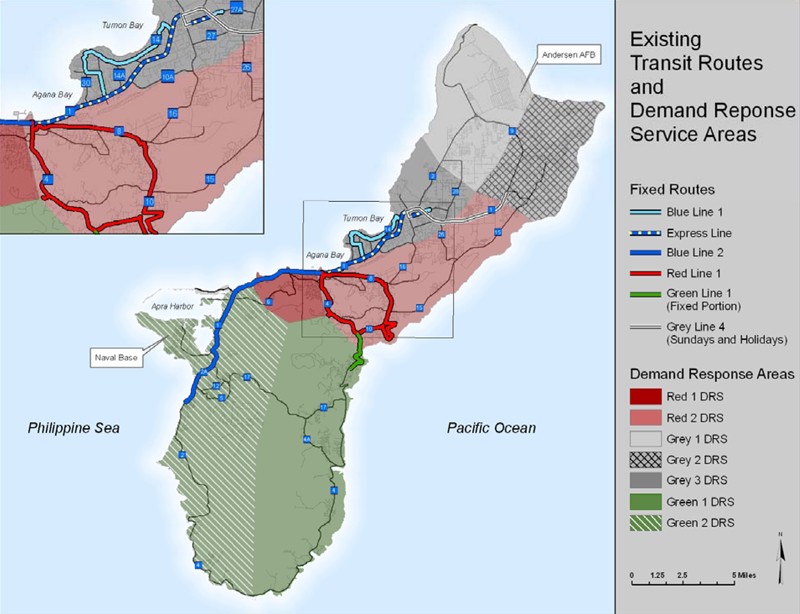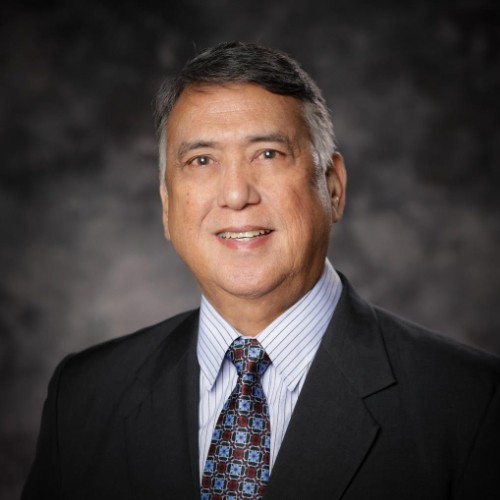Mass Transit
The existing Guam mass Transit System is comprised of three primary services; Fixed Route, Demand Response and Paratransit. The Fixed-route bus service is a system of regularly scheduled bus routes. Demand response service provides service by reservation to activity centers or areas with fixed-route service. Paratransit is a service for the disabled. Six fixed-route lines are offered and serve the major urban areas as shown in Figure 1. While this map would indicate that transit service is comprehensive on Guam, it is not. In many cases fixed-route transit schedules are not well matched to actual bus travel times resulting in a lack of predictability and poor service for transit customers. Indeed, investigations conducted for the 2030 GTP showed that buses often layover at the endpoints of their routes for time periods that are longer than the actual run times.
Extensive research conducted by the Parsons Brinckerhoff firm has shown that the present mass transit system on Guam has a great deal of room for improvement. Operational practices related to scheduling can vastly improve the reliability and accessibility of the fixed-route system. The current fleet of vehicles is also inadequate. They are old, expensive to operate, and, in some cases, do not meet ADA requirements. To address these and other deficiencies, the 2030 GTP developed an action plan.
The central recommendation of the 2030 GTP is the development of a core fixed-route system and demand-responsive service improvements. In the long-range component of the plan, it is anticipated that high-capacity transit improvements will be needed to support mobility for residents, visitors, and military personnel traveling Route 1. It is recommended that high-capacity transit concepts for Marine Corps Drive be implemented to enhance service and connectivity to the Tamuning/Tumon Bay area.
The current Territorial Transportation Improvement Program (TTIP) has programmed $20 million in funds to acquire the 50 new vehicles needed to start the system in 2012. The planning process for the Route 1 high-capacity transit service is likely to begin in 2015. The preliminary plan for the core system entails deploying five fixed-routes that will provide general-purpose service. The routes connect major population and employment centers, such as Dededo in the north, (the most populous residential district) and Apra Harbor in the south (a major location of jobs). The system also would connect the Finegayan facilities and the Yigo District/Anderson Air Force Base. Recommended routes are shown in the Figure on the left.
The daily service span for the system will be 18 hours per day. The service plan calls for one-hour headways for each of the five routes during the base period (9:00 a.m. to 4:00 p.m. and 6:00 p.m. to 11:00 p.m.) and 30-minute headways during peak periods (6:00 a.m. to 9:00 a.m. and 4:00 p.m. to 7:00 p.m.). The total fleet requirement for this service is 50 vehicles. Low floor buses are recommended for faster and easier boarding including direct access for people with disabilities.
Bus maintenance and administrative support facilities will also be needed. The bus maintenance facility would be designed for a fleet of up to 100 vehicles. Over the life of the 2030 GTP, it is foreseeable that the initial bus fleet of 50 vehicles will need replacement. During the 2015-2025 period, revenues are allocated to cover these capital costs.
Implementing the New Transit System
To implement the new transit system, DPW and the DOA are now in the process of preparing the materials necessary to undertake a turnkey procurement to secure an operating entity that will design, build, operate, and maintain the expanded system. A business plan is being prepared that documents the target markets, identifies operating and capital needs and costs, and provides site selection recommendations for a new maintenance facility.

File an Americans with Disabilities Act (ADA) Report

Office of the Governor of Guam


Meet our Leaders

